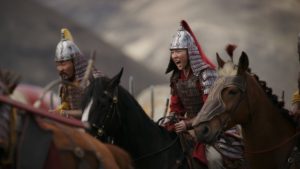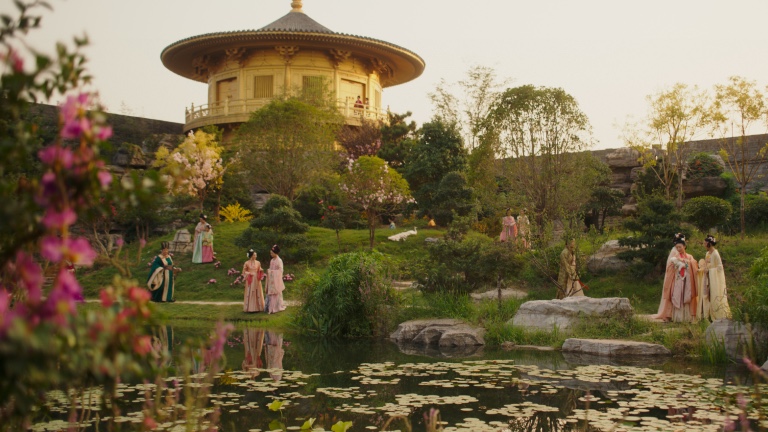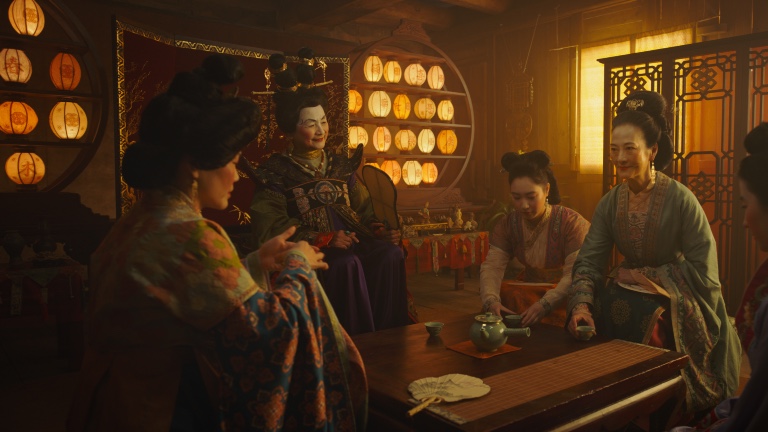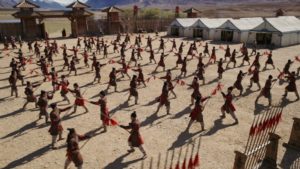
In 1998, Walt Disney Pictures released the animated movie Mulan, based on the Chinese narrative poem, The Ballad of Mulan. As with so many other animated movies from that period, Disney decided to convert Mulan into a live action epic, similar to last year’s Aladdin and Beauty and the Beast a few years earlier. Helming this remake is Niki Caro, the New Zealand filmmaker behind the 2002 drama Whale Rider, working from a script written by a pair of writing teams, Rick Jaffa and Amanda Silver, and Lauren Hynek and Elizabeth Martin.
The plot for this PG-13 movie is similar to the animated version with Yifei Liu playing Hua Mulan, a free-spirited young woman whose aging and injured military father (Tzi Ma) has been called to serve in the Imperial Army against the Northern invaders, led by Böri Khan (Jason Scott Lee). Not wanting to see her father die in battle, the brave Mulan steals his sword and armor and sneaks out in the night to take his place, pretending to be his son, Hua Jun.
Despite the similarities with the previous version, the filmmakers chose to remove a few notable elements, such as the songs and the comedy relief dragon Mooshu, voiced by Eddie Murphy. On the other hand, having a live action movie allows Caro to cast some true Chinese legends like Gong Li, Donnie Yen and Jet Li in key roles, making this a rare Hollywood movie with an all-Asian cast.

A movie that looks as stunningly gorgeous as Mulan owes a lot to some of the key crew and heads of department Caro brought on to what is clearly her biggest film to date. First and foremost, there’s Oscar-winning Production Designer Grant Major (The Lord of the Rings) and his Set Decorator Anne Kuljian (The Abyss, Minority Report), who, from the opening scene, set in Mulan’s slum-like village, create a living, breathing version of Mulan’s ancient China. Combine those sets with the work of Costume Designer Bina Daigeler — recently nominated for an Emmy for her work on FX’s Mrs. America – and you’re pulled into a world that you have no desire of leaving any time soon.
One issue I had with the costumes early on in the movie is that Mulan clearly lives in an impoverished village, and yet, the costumes are so bright and colorful. They really could have used a nice layer of dirt to maintain a level of veracity of what it must be like to live there. When we return to that location at the end of the movie, it’s far more appropriate for the colors to pop in order to enhance the film’s joyous ending. Before that, the decision not to age or weather the outfits takes away from how poor Mulan’s family is.
Other than my issues with the costumes, the rest of Daigeler’s work is quite glorious, whether it’s the standard military garb worn by everyone once Mulan gets to the Imperial army training camp or the majestic uniforms worn by Yen as her battalion’s Commander or Jet Li’s garb as the Emperor, things that really just stir the imagination as they hold you in this world, allowing for a fully escapist experience.

While the sets built bring a lot to creating this fantastical world, Caro and her team also have the benefits of some of China’s massive historical castles, some which we’ve already seen in movies like Zhang Yimou’s Hero and other similar historical epics. At a certain point, the movie shifts to mostly outdoor locations, although a few times, an actor or two might have a quiet moment on an “outdoor” set that’s obviously a well-lit soundstage, which effectively achieves something similar to some of the Asian films that inspired Caro and her crew, the work of Kurosawa in particular.
So much of that look deserves to be credited to Cinematographer Mandy Walker (Baz Luhrmann’s Australia) and the brilliant way in which every moment big or small is captured, whether it’s something that’s obviously on a sound stage or the expansive outdoor desert locations. The use of lighting to create shadows in some of the quieter scenes gives the film another level of mystique, used especially well in the scenes with the film’s antagonists. Caro’s regular editing collaborator, David Coulson, is there to make sure that every scene is paced just right, so you never get bored, even when just watching two people having a heart-to-heart.
The WETA team led by VFX Supervisor Anders Langlands (The Martian, War for the Planet of the Apes), is once again showing why they’re one of the top CG vendors on the planet, whether it’s using VFX to enhance the witch’s powers or extending the sets or armies to make them look more massive. WETA takes all the brilliant work done by every department and blends them together in a way that might make you question who deserves the most credit for some of Mulan’s more amazing visual moments.
Make no mistake that Mulan is first and foremost an action movie, and the enormous battle sequences, reminiscent of Braveheart, will add to the enjoyment of anyone who likes those kinds of movies. And yet, it’s often that the smaller one-on-one action sequences that are better examples of how different departments working together make the sum even better than all the individual parts. When the witch Xianniang, played by Gong Li, takes on a garrison of soldiers, we see how her outfit is used to stave off the men attacking her, showing how WETA finds a way to utilize Daigeler’s designs in a way that enhances the work of Caro’s stunt team.

As with Whale Rider, Mulan includes a number of highly-emotional tearjerker scenes. As much as some of that can be attributed to composer Harry Gregson-Williams (Shrek), there are many scenes where he wisely pulls back and allows Caro’s talented cast to just do their thing. These are fabulous performances that do not need the enhanced boost from over-scoring. Even so, it would be an understatement to say that Gregson-Williams’ musical choices represent one of the finest scores we’re likely to hear this year, mixing traditional Chinese instruments with Western orchestral swells to make every moment count.
Mulan really is Niki Caro’s magnum opus. On every level, it’s her most striking film since Whale Rider, and it allows us to see her working with a much bigger budget and with an amazing team of collaborators to create a film as grand as Crouching Tiger, Hidden Dragon or Braveheart. And yet, it’s also able to maintain the intimacy, characterization and emotional content that have permeated her smaller-budgeted films.
Mulan will be available to Disney+ subscribers in select regions for a premium fee of $29.99. For this review, the film was screened on an Apple MacBook Pro with a 13” screen.





